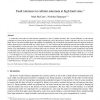Free Online Productivity Tools
i2Speak
i2Symbol
i2OCR
iTex2Img
iWeb2Print
iWeb2Shot
i2Type
iPdf2Split
iPdf2Merge
i2Bopomofo
i2Arabic
i2Style
i2Image
i2PDF
iLatex2Rtf
Sci2ools
JCSS
2008
2008
Fault tolerance in cellular automata at high fault rates
A commonly used model for fault-tolerant computation is that of cellular automata. The essential difficulty of fault-tolerant computation is present in the special case of simply remembering a bit in the presence of faults, and that is the case we treat in this paper. We are concerned with the degree (the number of neighboring cells on which the state transition function depends) needed to achieve fault tolerance when the fault rate is high (nearly 1/2). We consider both the traditional transient fault model (where faults occur independently in time and space) and a recently introduced combined fault model which also includes manufacturing faults (which occur independently in space, but which affect cells for all time). We also consider both a purely probabilistic fault model (in which the states of cells are perturbed at exactly the fault rate) and an adversarial model (in which the occurrence of a fault gives control of the state to an omniscient adversary). We show that there are c...
| Added | 13 Dec 2010 |
| Updated | 13 Dec 2010 |
| Type | Journal |
| Year | 2008 |
| Where | JCSS |
| Authors | Mark McCann, Nicholas Pippenger |
Comments (0)

